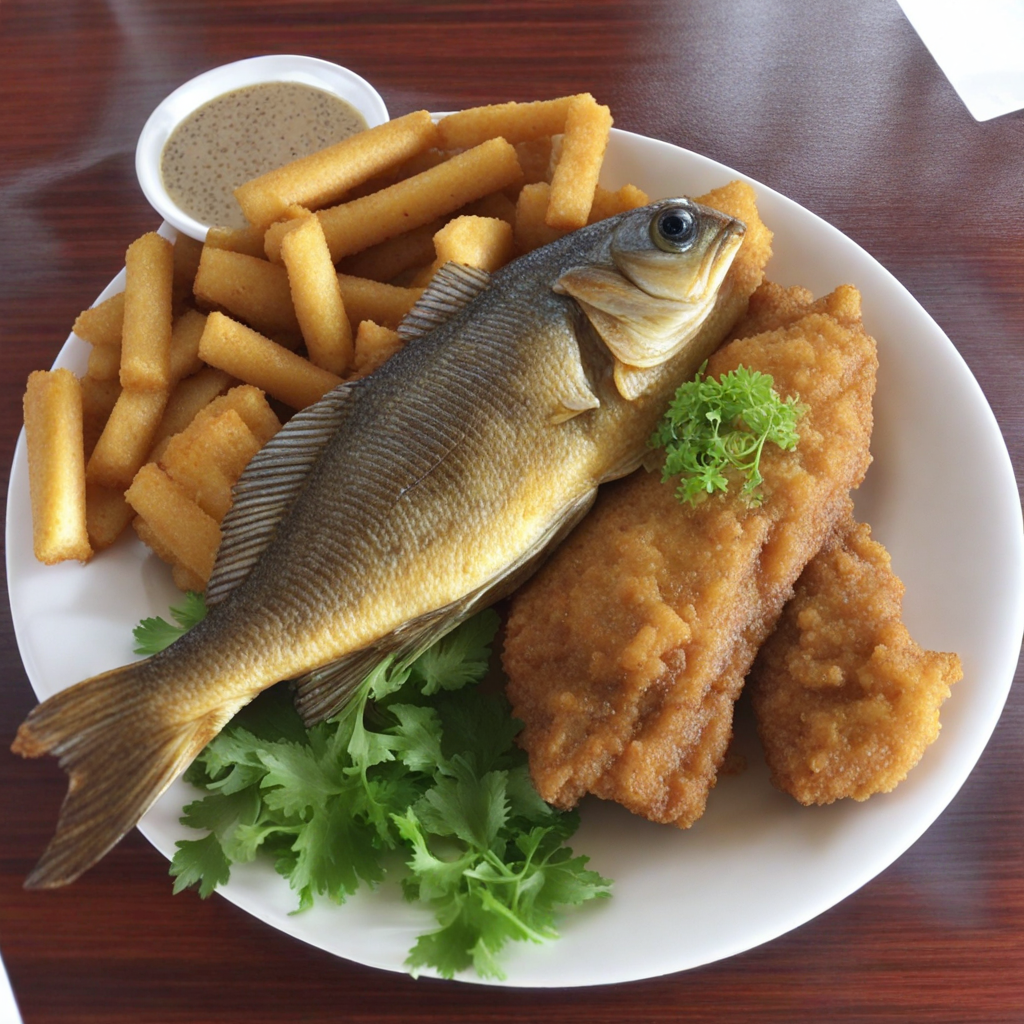Milk Tart
Milk Tart, a beloved dessert in Botswana, is a delightful custard tart that showcases the country's rich culinary heritage. This sweet treat features a buttery, crumbly pastry crust that encases a creamy filling made primarily from milk, sugar, and eggs. The filling is often subtly flavored with vanilla, lemon zest, or cinnamon, creating a harmonious balance of sweetness and warmth. Each bite melts in your mouth, revealing a velvety texture that is both comforting and indulgent, making it a perfect end to any meal or a sweet accompaniment to afternoon tea. The preparation of Milk Tart is both simple and rewarding, allowing the natural flavors of its ingredients to shine. The crust is typically made from flour, butter, and a hint of sugar, baked until golden brown. Once cooled, the custard-like filling is poured in, and the tart is often dusted with a sprinkle of ground cinnamon or nutmeg, enhancing its aromatic profile. Traditionally, Milk Tart is served chilled, allowing the flavors to meld beautifully while the creamy texture provides a refreshing contrast to the crisp crust. In Botswana, Milk Tart is more than just a dessert; it carries cultural significance and is often prepared for special occasions and gatherings. It reflects the warm hospitality of the Botswana people, as sharing food is an integral part of their social fabric. As you savor a slice of Milk Tart, you'll not only experience a unique blend of textures and flavors but also a taste of the rich traditions and communal spirit that defines Botswana's culinary landscape.
How It Became This Dish
Terata ya Mašwi: A Culinary Journey Through Botswana Origin and Ingredients Terata ya Mašwi, often referred to as “sour milk porridge,” is a traditional dish deeply rooted in the cultural and culinary practices of Botswana, a landlocked country in Southern Africa known for its rich history and diverse ethnic groups. The term 'Mašwi' translates to 'sour milk' in the Tswana language, a reflection of the primary ingredient that defines this beloved dish. The porridge is made from fermented milk, usually cow's milk, which is allowed to sour through natural fermentation processes, giving it a distinct tangy flavor. The origins of Terata ya Mašwi can be traced back to the pastoral traditions of the Tswana people, who have inhabited the region for centuries. Historically, the Tswana were semi-nomadic herders, relying on cattle for sustenance, and milk was a cornerstone of their diet. The practice of fermenting milk likely began as a method of preservation, allowing for the consumption of dairy products long after the milk was harvested. This practice not only contributed to food security but also gave rise to various dairy-based dishes, with Terata ya Mašwi being among the most cherished. Cultural Significance Terata ya Mašwi holds a special place in the hearts of many Batswana (the people of Botswana) and is often associated with community gatherings, celebrations, and traditional ceremonies. It is not just a meal; it embodies a way of life, connecting individuals to their heritage and ancestors. The preparation and sharing of this dish often take place during significant events, such as weddings, funerals, and initiation ceremonies, where it serves as both nourishment and a symbol of unity. In a broader cultural context, Terata ya Mašwi reflects the agricultural and pastoral lifestyle of Botswana. It is a testament to the resourcefulness of the Batswana, who have learned to make the most of their natural resources. The dish is often accompanied by other traditional foods, such as meat stews or vegetables, creating a wholesome meal that emphasizes communal dining—an essential aspect of Tswana culture. Preparation and Variations Traditionally, Terata ya Mašwi is prepared using a simple process. The sour milk is mixed with cornmeal (maize) and water, and then cooked over low heat until it thickens to a porridge-like consistency. Depending on personal preferences and regional variations, sugar or salt may be added to enhance the flavor. The dish can be served warm or chilled, making it a versatile option suitable for any time of the day. While the basic recipe remains consistent, various adaptations exist across different communities. In some regions, people may incorporate ingredients such as pumpkin or sorghum to diversify the flavor profile and add nutritional value. Additionally, the porridge can be garnished with fresh fruits, nuts, or honey, creating a delightful contrast of textures and tastes. Development Over Time As Botswana has evolved, so too has the culinary landscape, including the preparation and consumption of Terata ya Mašwi. The dish has remained a staple in many households, but modern influences and urbanization have led to changes in how it is prepared and enjoyed. In urban centers like Gaborone, the capital, traditional foods often compete with fast food and global cuisines, leading to a gradual shift in eating habits. However, there has been a resurgence of interest in traditional Botswana cuisine, with efforts to preserve and promote local foods like Terata ya Mašwi. This revival is partly driven by a growing awareness of the importance of food heritage and the nutritional benefits of traditional diets. Local restaurants and food festivals have begun to showcase traditional dishes, bringing Terata ya Mašwi back into the spotlight and encouraging younger generations to embrace their culinary heritage. Moreover, the global food movement has also played a role in the re-evaluation of traditional dishes, with a focus on sustainability and local sourcing. As consumers become more conscious of what they eat, the appeal of authentic, locally-produced foods like Terata ya Mašwi has increased. This shift has led to a renewed appreciation for the culinary traditions of Botswana, fostering a sense of pride among the Batswana for their rich gastronomic heritage. Contemporary Relevance In contemporary Botswana, Terata ya Mašwi continues to be a beloved comfort food, often enjoyed as a breakfast option or a light meal. It resonates with the values of community and tradition, serving as a reminder of the importance of family and shared experiences around the dining table. The dish's simplicity and versatility make it an enduring favorite, transcending generational divides. Moreover, Terata ya Mašwi has begun to attract attention beyond Botswana's borders. As travel and cultural exchange increase, traditional dishes from Africa are being discovered and celebrated on the global stage. Food enthusiasts and chefs alike are exploring the unique flavors and stories behind dishes like Terata ya Mašwi, incorporating them into menus that highlight authentic African cuisine. Efforts to document and share the culinary practices surrounding Terata ya Mašwi are also underway, with cookbooks and online platforms dedicated to preserving traditional recipes and cooking techniques. This initiative not only promotes the dish itself but also fosters awareness of the cultural narratives associated with it, ensuring that future generations can appreciate and continue the legacy of this iconic Botswana dish. Conclusion Terata ya Mašwi is more than just a dish; it is a culinary emblem of Botswana's rich cultural heritage. Rooted in the pastoral practices of the Tswana people and embraced by communities across the nation, this sour milk porridge has withstood the test of time, adapting to changing tastes and lifestyles. As Botswana continues to evolve, Terata ya Mašwi remains a poignant reminder of the importance of tradition, community, and the enduring connection between food and culture. Whether enjoyed at a family gathering or celebrated in a contemporary restaurant, it is a dish that tells the story of a people, their history, and their love for the land they call home.
You may like
Discover local flavors from Botswana







